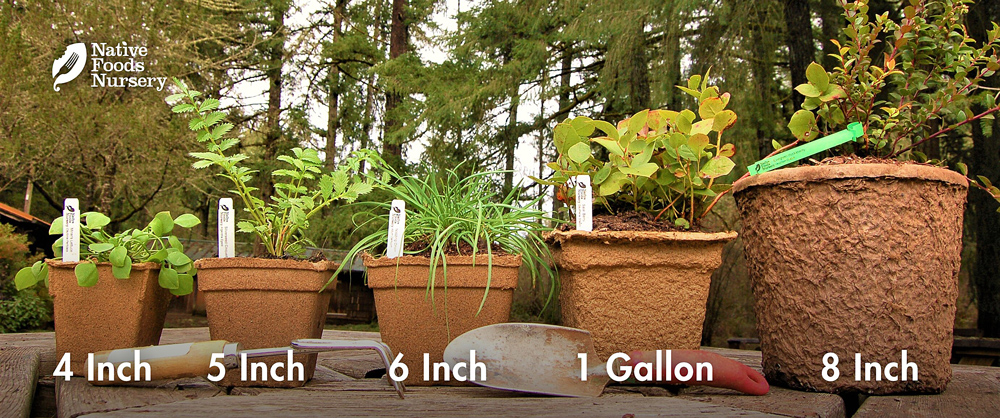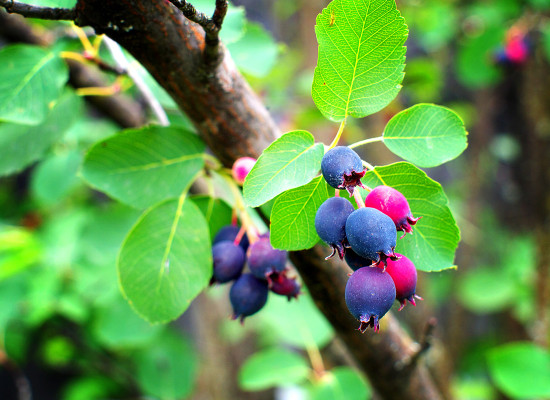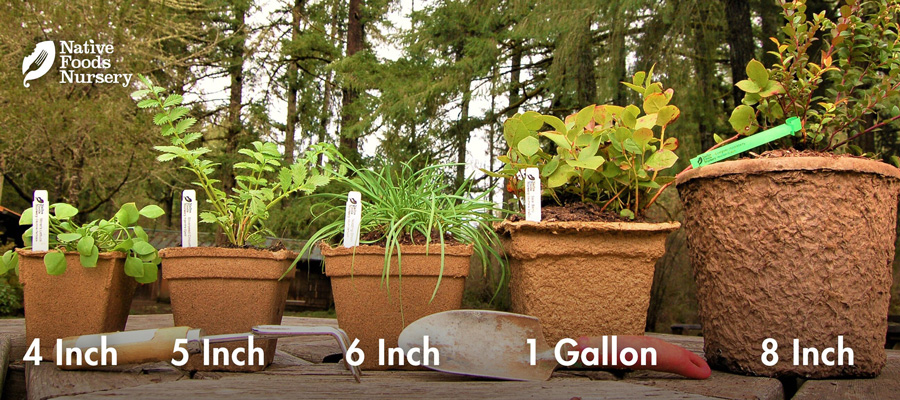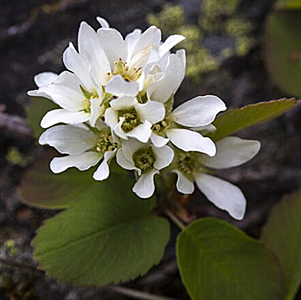Saskatoon Serviceberry ~ Northline-Martin-Smoky
- Current Stock:
- 0
- Condition:
- New
- Other Names:
- shadbush, shadwood/shadblow, sarvisberry, juneberry, sugarplum, chuckley pear, i-d mštiyu (Clackamas Chinook, pronounced "ee-DUHM-stee-yoo"))
- Latin Name:
- Amelanchier alnifolia
Serviceberry (Amelanchier alnifolia) is a beloved native shrub or small tree, known for snowy white spring blossoms, luscious summer berries, and brilliant fall foliage. A four-season beauty, it brings ornamental grace and edible abundance to gardens and wild landscapes alike [1][2][8].
Note: We offer Northline, and this Winter, will also be offering two other complimentary varieties - Smoky and Martin. Planted together, they improve yield, offer unique edible qualities, expand the harvest window, and grow a variety of heights/shapes. See detailed comparison table at the bottom.
Edible Uses
Serviceberries are among the finest native fruits, long celebrated for sweet, versatile berries enjoyed fresh, baked into pies and muffins, dried for trail snacks, or simmered into jams, syrups, and wines. They are nutritionally dense, with fiber, protein, and antioxidants noted in the literature [5][9][10], putting them in the same category as other medicinal-edible berries like Blueberry, Aronia, and Seaberry.
Among cultivars, ‘Northline’ delivers sweet, balanced flavor with fairly uniform clusters for fresh eating and baking; ‘Smoky’ is a very heavy producer with mild-sweet berries ideal for preserves; and ‘Martin’ bears very large, firm fruit that shines for fresh eating and pies [1][3][6].
Ornamental Qualities
Clouds of early white flowers, attractive bark, edible fruit, and glowing orange-red autumn foliage make Serviceberry a standout specimen, hedgerow anchor, or native orchard companion [4][7]. Pairs well as an understory for trees like Oregon White Oak, or as an overstory for smaller berries like Salal or Salmonberry.
Environment and Culture
Ranging from Alaska to California and across much of the northern U.S., Serviceberry thrives in open woods, streambanks, and dry hillsides [1][2][8]. Its fruit feeds birds and mammals while flowers support early pollinators [6]. Planting two or more cultivars (e.g., Northline + Smoky or Northline + Martin) improves set and evens out spring-weather risk via cross-pollination [1].
Indigenous communities continue to value Serviceberry as a staple fruit and cultural resource, drying berries and incorporating them into traditional foods. Honoring Indigenous stewardship acknowledges the relationships and knowledge that sustain both plant and place [5][9]. (Learn more & how to help on our Charitable Giving page.)
Harvest, Care, and Preparation
Grow in acidic, well-drained soil with partial sun to light shade. Choose cooler sites if possible and mulch with organic matter. Provide consistent moisture during dry spells. Harvest when fully colored and flavorful — often later than blueberries, depending on elevation [4][7]. Berries ripen in early to mid-summer and can be harvested over several weeks. (See Planting Guide in next tab for more info.)
***NOTE: When planted in areas with Incense Cedar (Calocedrus decurrens) or Juniper spp., Serviceberries can develop a rust that can significantly reduce fruit viability. Organic fungal sprays, applied early and regularly, can reduce or eliminate the problem.
Attributes
Native Range: AK-CA; east to UT/CO and the Upper Midwest (IA/MN); across BC→Prairies→ON/QC→NWT.
USDA Zones: 2-8 (some nurseries list 3; Canadian listings as low as 2a-1).
Ease of Care: Easy
Deer Resistance: Moderate
Light Requirements: Full sun to partial shade
Soil Type: Best in well-drained loam; adaptable; pH ~5.5–7.5.
Water Requirements: Keep evenly moist for best crops; limited drought tolerance.
Pollination: Self-fertile; bigger yields with a second Saskatoon cultivar.
Bearing Age: ~2–4 years from planting (seedlings can take longer).
Size at Maturity: Typically 6–10 ft (can be maintained ~5–7 ft); suckers to form thickets.
Bloom Time: April–June (region-dependent).
Harvest Time: Early–mid summer; often mid-July for ‘Northline’.
Comparison Table for Varieties
| Attribute | Northline | Martin | Smoky |
|---|---|---|---|
| Bloom & Pollination | Early–mid spring; self-fruitful but better yields with a different cultivar nearby[1]. | Mid spring; good pollen partner with other cultivars; self-fruitful[1]. | Mid–late spring; self-fruitful; cross-pollination improves set[1]. |
| Ripening Window (PNW) | Mid season; clusters ripen fairly uniformly (June–July at low elevations)[3]. | Mid to mid-late; selected for more uniform ripening than Thiessen[1][3]. | Mid to mid-late; heavy crops (late June–July)[3]. |
| Fruit Size (approx.) | Large ~15–16 mm[1] | Very large ~16–18 mm (Thiessen lineage)[1] | Medium-large ~13–15 mm[1] |
| Berry Firmness | Medium-firm; good fresh and for baking[1]. | Firm; excellent fresh eating and handling[1]. | Softer; popular for preserves/drying[1]. |
| Yield | High and consistent[1]. | Medium to high with cross-pollination[1]. | Very high; widely planted for productivity[1][6]. |
| Plant Habit & Height (mature) | Upright-spreading; typically 6–10 ft in gardens; larger in orchards[2]. | Upright/round; ~7–10 ft[1]. | Upright-spreading; ~10–15 ft[1][2]. |
| Height at ~5 Years (PNW typical) | ~4–6 ft (site-dependent)[2][3]. | ~5–7 ft (vigorous, upright)[1][3]. | ~5–7 ft (vigorous; can be taller on rich soils)[2][3]. |
| Suckering | High; forms thickets/patches readily[1][2][3]. | Moderate[1][3]. | High; good for hedging[1][2][3]. |
| Best Use | Fresh + baking; uniform clusters simplify harvest[1][3]. | Premium fresh fruit (large, firm); great for pies/drying[1]. | Processing (jams, syrups, drying) and heavy home harvests[1]. |
| Rust / Disease Notes | No specific rust resistance reported; site with airflow; avoid nearby junipers where rust is an issue[1]. | Same as left; general sanitation and pruning advised[1]. | Same as left; thin vigorous growth for airflow[1]. |
| Good Pollination Partners | Martin or Smoky (any two different cultivars improve yield)[1]. | Northline or Smoky[1]. | Northline or Martin[1]. |
References
[1] USDA PLANTS Database — species profile.
[2] Flora of North America — taxon treatment.
[3] Jepson eFlora / Calflora — distribution & habitat.
[4] Oregon State University Landscape Plants — horticultural notes.
[5] Moerman, Native American Ethnobotany — Indigenous food use.
[6] USFS/NRCS Plant Guides — wildlife value.
[7] Native Plant Network & Extension publications — garden care.
[8] Pojar & MacKinnon, Plants of the Pacific Northwest Coast — ecology & natural history.
[9] Turner, ethnobotany works — cultural tending & food use.
[10] Peer‑reviewed nutrition/phytochemistry — antioxidants, vitamins.
Pot Sizing Guide

Planting Guide: Saskatoon Serviceberry (Amelanchier alnifolia)
Tip: Aim for a “prairie woodland edge.” Choose a sunny, airy spot with well-drained, organic-rich soil. Give space from susceptible Juniperus to reduce cedar-quince rust risk, and keep steady summer water for plump berries.
Choosing a Site
Light: Full sun to part shade; best fruiting with 6+ hours of direct sun.
Soil: Well-drained loam or sandy loam enriched with compost; moderately acidic to neutral (approx. pH 5.5–7.5).
Space: Single plants 6–8 ft apart (hedge at 4–5 ft). Allow light suckering for a thicket, or remove suckers to maintain a single clump.
Planting Steps
Plant in spring or fall; in hot-summer regions, favor early spring or cool fall weather.
Dig a wide hole; blend native soil with composted bark/leaf mold for drainage and moisture retention.
Set crown at original soil line; backfill gently and water deeply to settle.
Mulch 2–3 in. with wood chips or pine needles (keep mulch a few inches off the stem).
Watering & Care
Establishment: Keep evenly moist during the first 1–2 years.
After establishment: Fairly drought-tolerant, but steady summer water improves berry size and yield.
Pruning: After harvest, thin out a portion of the oldest canes to renew growth. Allow limited suckers for a hedge or remove for a single-stem look.
Fertilizing: Light spring compost or slow-release organic feed only if growth is weak; avoid heavy nitrogen.
Pollination: Self-fertile; bigger crops with a second Saskatoon cultivar nearby (e.g., pair Northline with Smoky or Martin for reliable overlap and yield).
Heat & Airflow: Provide good air circulation and avoid crowding to reduce foliar diseases.
Protection
Rust management: Keep distance from susceptible Juniperus (alternate hosts of cedar-quince/related Gymnosporangium rusts). Improve airflow, prune out infected twigs, and clean up leaf/fruit mummies.
Wildlife: Birds relish berries—consider lightweight netting as fruit colors.
Cold & Deer: Very hardy (often listed to USDA 2–3). Deer browse can be moderate; protect young plants where pressure is high.
Companions: Pair with Evergreen Huckleberry, Red Flowering Currant, Oso Berry, and native grasses for a resilient edible hedge; underplant with strawberries or sedges.
Harvest Basics
Timeline: First fruit typically 2–4 years after planting.
Season: Early to mid-summer; Northline is often mid-season with fairly uniform clusters, Smoky is mid-season and very productive, and Martin tends mid–late—often extending the picking window by 1–2+ weeks depending on climate.
Use: Excellent fresh, frozen, dried, or cooked—pies, jams, syrups, muffins, fruit leather; seeds lend a gentle almond-like note.








